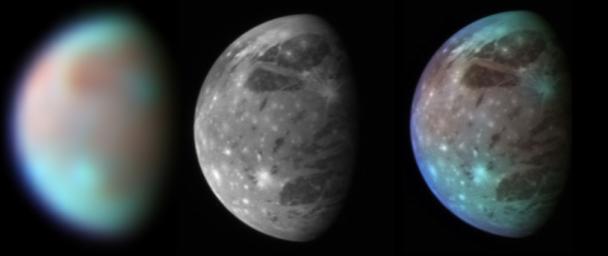
|
Ganymede in Visible and Infrared Light
- Click the image above for a larger view
- Full-Res JPEG (814 x 343) (19.1 kB)
- Full-Res TIFF (814 x 343) (838.8 kB)
Caption:
This montage compares New Horizons' best views of Ganymede, Jupiter's largest moon, gathered with the spacecraft's Long Range Reconnaissance Imager (LORRI) and its infrared spectrometer, the Linear Etalon Imaging Spectral Array (LEISA).
LEISA observes its targets in more than 200 separate wavelengths of infrared light, allowing detailed analysis of their surface composition. The LEISA image shown here combines just three of these wavelengths -- 1.3, 1.8 and 2.0 micrometers -- to highlight differences in composition across Ganymede's surface. Blue colors represent relatively clean water ice, while brown colors show regions contaminated by dark material.
The right panel combines the high-resolution grayscale LORRI image with the color-coded compositional information from the LEISA image, producing a picture that combines the best of both data sets.
The LEISA and LORRI images were taken at 9:48 and 10:01 Universal Time, respectively, on February 27, 2007, from a range of 3.5 million kilometers (2.2 million miles). The longitude of the disk center is 38 degrees west. With a diameter of 5,268 kilometers (3,273 miles), Ganymede is the largest satellite in the solar system.
Cataloging Keywords:
| Name | Value | Additional Values |
|---|---|---|
| Target | Ganymede | |
| System | Jupiter | |
| Target Type | Satellite | |
| Mission | New Horizons | |
| Instrument Host | New Horizons | |
| Host Type | Flyby Spacecraft | |
| Instrument | Linear Etalon Imaging Spectral Array (LEISA) | Long Range Reconnaissance Imager (LORRI) |
| Detector | ||
| Extra Keywords | Color, Infrared, Visual, Water | |
| Acquisition Date | ||
| Release Date | 2007-05-01 | |
| Date in Caption | 2007-02-27 | |
| Image Credit | NASA/Johns Hopkins University Applied Physics Laboratory/Southwest Research Institute | |
| Source | photojournal.jpl.nasa.gov/catalog/PIA09356 | |
| Identifier | PIA09356 | |
